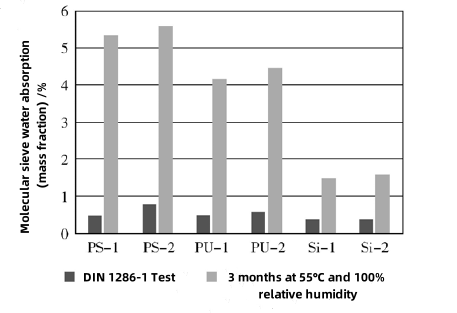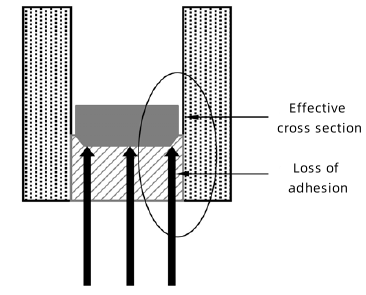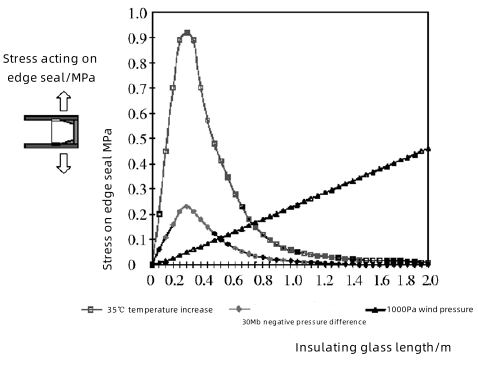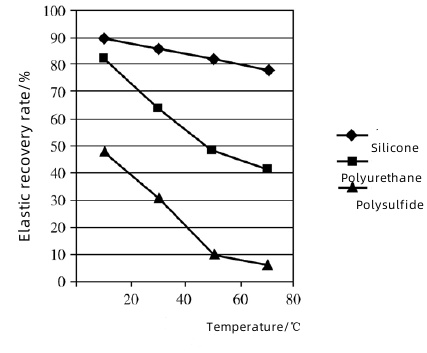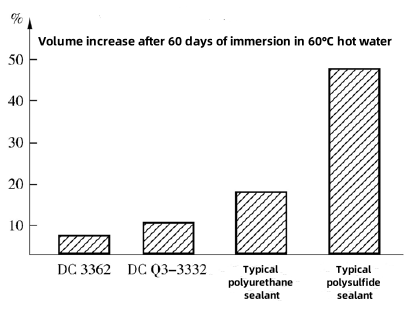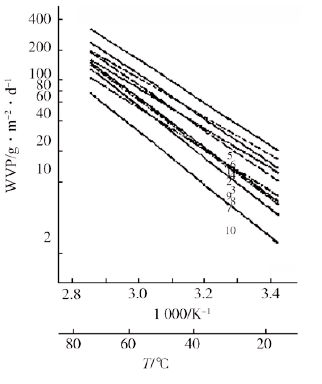Comparison of the permeability of insulating glass sealed by silicone and organic sealant.
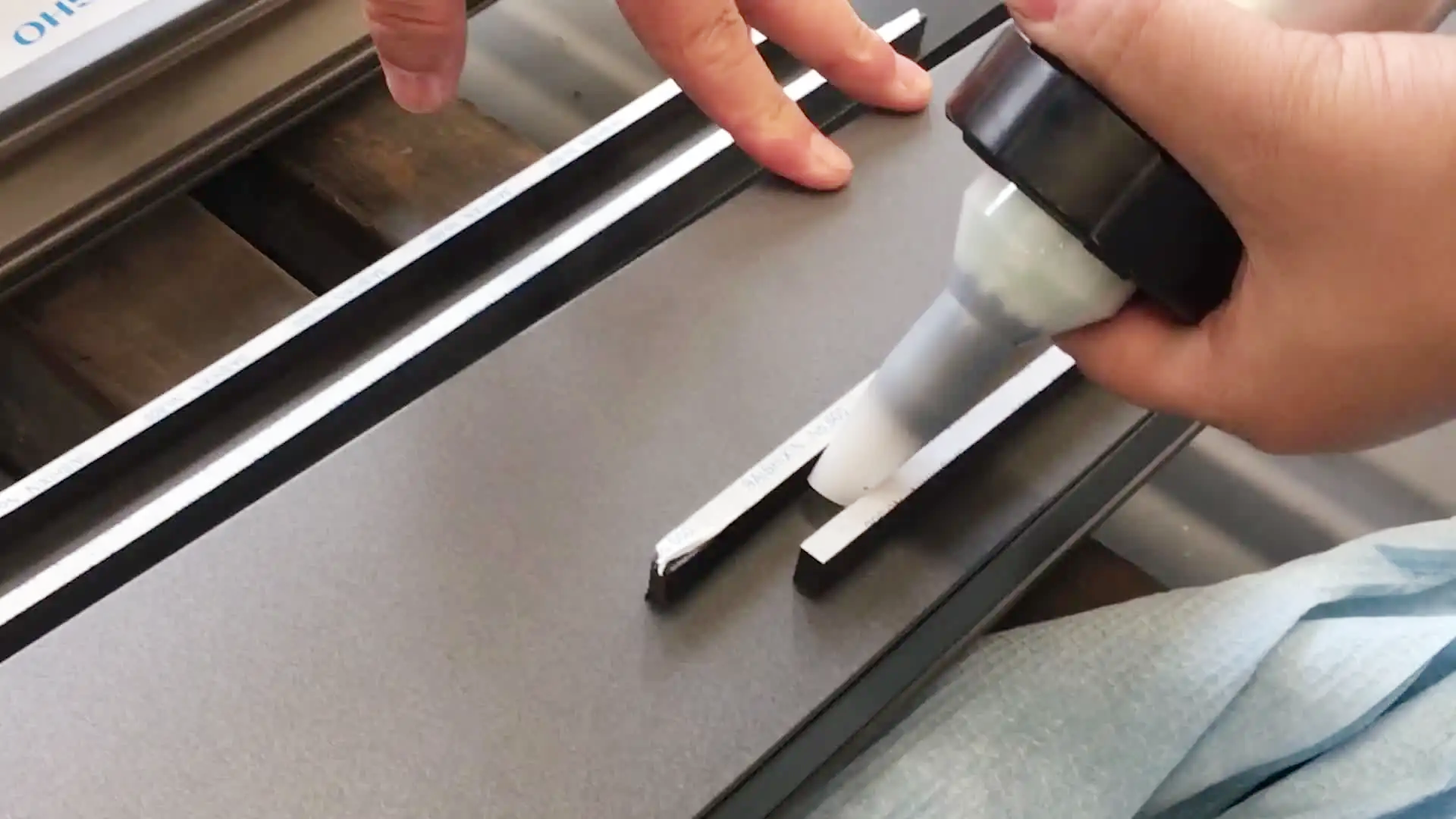
Organic sealant has a long history of application as a second seal for insulating glass and has been used to this day. Therefore, in the minds of most people, it has always been believed that insulating glass sealed by organic sealant has the best resistance to water vapor permeability.
1. Comparison of the permeability of insulating glass sealed by silicone and organic sealant
Organic sealant has a long history of application as a second seal for insulating glass and has been used to this day. Therefore, in the minds of most people, it has always been believed that insulating glass sealed by organic sealant has the best resistance to water vapor permeability. For insulating glass with single seal, this understanding may be correct, but for insulating glass with double seal, it is not entirely true. Because the actual engineering verification in recent years has confirmed that the performance of insulating glass with silicone as a second seal, especially the resistance to water vapor permeability, is significantly better than that of insulating glass sealed by organic sealant.
According to the latest foreign research report, the water absorption of molecular sieves, i.e., water vapor permeability, can be compared under DIN1286-1 temperature/humidity cycle and 3-month exposure to constant high temperature (55 ℃) and constant high humidity (100%) for different double-sealed insulating glass. Please refer to Figure 1 and Table 1. As can be seen from the chart, the water vapor permeability of insulating glass tested under constant climate conditions is higher than that under cycle conditions. Among them, the insulating glass using silicone as the second seal showed a lower water vapor permeability than the insulating glass using organic sealant as the second seal. This result proves that the performance of insulating glass should not and cannot only consider the water vapor permeability of the second seal material, but must consider the entire system. Experimental data show that under constant high temperature and high humidity, silicone-sealed insulating glass has a more significant performance advantage; the water vapor permeability of organic-sealed insulating glass is about 3 times that of silicone. Because the water absorption rate of desiccant is inversely proportional to the average life of insulating glass, this finding shows that the service life of insulating glass with silicone as the second seal is much better than that of insulating glass sealed with polysulfide or polyurethane so far.
Table 1 Water vapor permeability of insulating glass after different accelerated exposure conditions (mass fraction) / %
| Second sealant | Water absorption after DIN-1286-1 test | Water absorption after 3 months at 55℃ and 100% humidity |
| Polysulfide sealant 1 | 0.5 | 5.4 |
| Polysulfide sealant 2 | 0.8 | 5.6 |
| Polyurethane sealant 1 | 0.5 | 4.2 |
| Polyurethane sealant 2 | 0.6 | 4.5 |
| Silicone sealant 1 | 0.4 | 1.5 |
| Silicone sealant 2 | 0.4 | 1.6 |
The French Insulating Glass Association (CEKAL) had earlier analyzed those insulating glass that failed prematurely. They found that all the failed insulating glass had different degrees of second-line seal adhesion damage under ultraviolet irradiation, and there was no case of silicone as the second seal. The German Door and Window Research Institute (IFT) also reported the same trend at about the same time.
Figure 1 Water vapor permeability of insulating glass with different secondary seals under temperature/humidity cycles and constant temperature and humidity conditions
2. The usual service life and potential failure factors of insulating glass
In Europe, the service life of insulating glass is required to be at least 25 years. The gas-filled insulating glass requires the gas leakage rate to be less than 1% per year, and the total gas leakage rate is required to be less than 5% within the 25-year service life after accelerated aging. Assuming that the U value of insulating glass increases by 0.4W/(m2K) after 100% argon filling, the U value reduction caused by gas loss during its service life should be less than 0.04W/(m2K).
In fact, the service life and thermal conductivity of insulating glass are affected by the following factors:
- The diffusion resistance of edge seals to water vapor and gas.
- The effective cross-sectional size of the sealant when water vapor or gas diffusion occurs.
- The durability of the edge seal.
The water vapor and gas permeability of the first seal is much lower than that of the second seal. Therefore, the service life is usually determined by the diffusion amount through the cross-sectional area of the first seal, as shown in Figure 2.
Figure 2 Effective cross-sectional area of insulating glass
The IFT research report pointed out that more than 95% of potential failure cases are caused by the loss of adhesion of the second seal, such as the poor durability of the second seal.
3. Changes in the water vapor transmission mechanism caused by aging of the edge seal
In order to study the causes of premature failure of insulating glass, Van Santen and Schlensog conducted in-depth research on this. The aging of the edge seal caused by the exposure of insulating glass to the environment or due to service degradation factors can cause changes in the water vapor transmission mechanism, resulting in water vapor intrusion or gas leakage. If the water vapor permeability increases significantly during the use of insulating glass, it indicates that the system is aging, so the increase in water vapor permeability is a good indicator to judge whether the system is aging or not. Before aging, in a steady state, when the desiccant is far from saturation, the amount of water vapor intruding into the insulating glass per unit time should be constant. When the desiccant in the insulating glass is close to saturation, the intrusion of water vapor should slow down because the local pressure difference is balanced. However, in the laboratory and in the field, when the insulating glass is subjected to repeated humidity and temperature cycle tests, the water vapor permeation often shows a nonlinear increase with the increase of exposure time (Van Santen 1986, Marusch 1988), as shown in Figure 3. Van Santen (1986) attributed this behavior to the movement of the edge seal caused by temperature and pressure fluctuations, which caused the physical degradation of the first seal. Due to this repeated movement, the first seal may fail cohesively or adhesively. Both failure mechanisms can be observed in the actual use of insulating glass, usually accompanied by the penetration of the PIB first seal into the visible cavity.
Figure 3 Nonlinear characteristics of water absorption of insulating glass after aging
Schlensog (1986) observed the process of loss of adhesion of the organic sealant second seal on the glass after ultraviolet irradiation by polarizing microscopy. As we all know, when sunlight hits conventional insulating glass, a certain amount of incident light reaches the edge seal through internal reflection of the glass. When exposed to such a lethal short-wave spectrum for a certain period of time, the organic sealant will lose its glass adhesion. The study also showed that when the edge seal adhesion or boundary damage can be detected, the delamination under microscopic conditions already exists. As the exposure time continues, the delamination becomes larger and interconnected, and finally leads to macroscopic failure. It is very likely that before the macroscopic failure occurs, water vapor and gas penetrate into the inner cavity along the damaged area of the interface, and the invasion of water vapor may accelerate this failure mechanism.
The temperature change of the edge seal causes periodic shear and peel forces between the spacer and the glass due to different thermal expansion coefficients, and generates high stresses on the edge seal, which may be superimposed with the aging effects. The shear displacement in the interface will produce high tensile stresses near the contact surface between the sealant and the substrate, which is almost twice the original shear stress, which is why the sheared sealant is prone to fail on the substrate surface. If the second sealant hardens over the service life, the increase in tensile stress may cause partial or complete loss of adhesion.
4. Effective diffusion cross section
The control of the size of the effective cross section through the edge seal when water vapor or gas diffusion occurs often depends on the insulating glass manufacturing process. The correct insulating glass manufacturing process can reduce the effective cross section through the edge seal when water vapor or gas diffusion occurs. The manufacturing process requires that the first seal must be free of bubbles and completely wet the contact surface between the spacer and the glass in addition to reaching the correct size. For rigid spacers, the expansion of the first seal under positive pressure is determined by the tensile strength of the second seal to resist the force. In fact, positive pressure differences exist when the atmospheric pressure is low or at high temperatures, and temperature is the cause of most pressure differences. The pressure difference caused by temperature exerts a much higher force on the edge seal than the force caused by wind pressure and atmospheric pressure changes (see Figure 4). Therefore, the tensile stress behavior (Young's modulus) of the second seal at high temperature must be considered. The higher the tensile resistance of the second seal, the better the diffusion cross section of the first seal will be maintained.
Figure 4 Effect of stress caused by temperature and pressure fluctuations on the diffusion cross section
In addition, a further factor affecting the service life and U value of insulating glass is the duration of the expansion of the first seal. Regardless of the type of second seal used, this opening time always exists with the period of positive pressure difference. As mentioned above, the degree of opening depends on the tensile strength of the second sealant. However, once the positive pressure difference decreases and the internal and external pressure differences are balanced, the length of time required for the edge seal to close the opening of the first seal varies depending on the elastic recovery rate of the second sealant used. Sealants with low elastic recovery rates show viscous flow in their stress-strain behavior, and due to this stress relaxation principle, their tensile stress decreases during the period of extension. As a result, when the external force is removed, they no longer have the ability to quickly close the opening of the first seal to its original size. If the second seal cannot be fully recovered, the first seal will leave a permanent deformation. In addition, because the opening of the diffusion channel mainly exists during the high temperature period, the second sealant with a poor elastic recovery rate will significantly shorten the service life of the insulating glass during the high temperature period.
In addition to the fluctuations in temperature and atmospheric pressure, the water vapor standard level in the surrounding environment also indirectly affects the opening and closure of the first seal. In the presence of high water vapor levels or higher, such as direct contact with liquid water, the absorption of water by the second sealant will increase its volume and reduce its mechanical properties. In general, the lower the cross-link density of the polymer sealant grid, the higher its water absorption. For most sealants, the degree of negative impact caused by water absorption is proportional to the total amount of water absorbed. Water absorption by the second seal causes the opening of the first seal to expand, so the effective diffusion cross-sectional area is also increased.
5. Effects of environmental factors on insulating glass and performance requirements of edge seals
Insulating glass is exposed to different environmental and usage factors, which have a negative impact on the average life of insulating glass. The literature on this aspect often divides these effects into physical effects (such as temperature and pressure fluctuations, etc.) and chemical effects (such as atmospheric environment, chemicals, etc.). Among them, some environmental effects, such as sunlight and water vapor, will produce both physical and chemical effects.
High temperature accelerates most physical and chemical reactions, such as aging of insulating glass sealants and accelerated diffusion of water vapor or gas through edge seals. Temperature fluctuations cause pressure changes in insulating glass.
These pressures will cause mechanical stresses on the edge seals, which are strongest for small sizes and form the greatest stress on the edge seals. In addition, after heating, as mentioned above, the different thermal expansion coefficients of the spacer and the glass sheet will cause shear and peel forces to act on the edge seals.
The temperature of the edge seal is affected by the daily and annual changes in the ambient temperature, which causes the temperature of the edge seal to change rapidly accordingly. According to statistics, during the service life of the insulating glass (25 years), 2,000 pressure fluctuations are caused by the atmosphere (climate), about 20,000 by solar radiation, and about 400,000 by wind pressure. These pressure fluctuations will act on the edge seals repeatedly, affecting the average life of the insulating glass. Therefore, a good insulating glass edge seal must have the following characteristics:
- Weather resistance, that is, resistance to environmental factors (taking into account both physical properties and adhesion).
- Structural strength that inhibits the movement of the edge seal to minimize the change in the effective diffusion cross-sectional area of the first seal.
- Low water vapor and gas permeability under the conditions of use.
6. Characteristics of insulating glass as the second seal
Silicone as the second seal of insulating glass can maintain excellent performance in harsh natural environments because silicone itself has some chemical properties that organic sealant cannot achieve.
6.1 Anti-aging properties
The Si-O bond of silicone polymer itself has a high bond energy and a large bond angle, so it is transparent to ultraviolet rays and most invisible light with a wavelength below 280nm, and the Si-O bond will not be easily broken. Secondly, the interaction force between silicone molecules is relatively weak, and the molecular chain is flexible, which makes silicone polymer have good elasticity and is almost unaffected by ambient temperature, especially extreme high and low temperatures.
6.2 Elastic modulus
The elastic modulus of organic glue gradually decreases with the increase of temperature. From -20 ℃ to 70 ℃, the modulus of polysulfide glue will decrease by 40%, and that of polyurethane will decrease by about 60%, while silicone is almost unaffected by it and its modulus remains basically unchanged.
6.3 Elastic recovery rate
Similarly, silicone generally exhibits good elastic recovery rate due to its inherent molecular properties, while organic glue exhibits its thermoplasticity, that is, its elastic recovery rate will gradually decrease with increasing temperature
(see Figure 5).
Figure 5 Relationship between elastic recovery rate and temperature
6.4 Water absorption rate
By absorbing water, water and water vapor can cause natural stress in the edge seal and expansion of the insulating glass sealant itself. Organic glues are hydrophilic and generally exhibit high water absorption rates, while specially formulated sealants (such as DC3362) exhibit lower water absorption rates than general silicone sealants (see Figure 6).
Figure 6 The comparison of water absorption of sealants
6.5 Water vapor diffusion at high temperatures
Temperature greatly affects the water vapor and gas permeability of insulating glass sealants. As the temperature increases, the diffusion rate of water vapor and gas will accelerate. The water vapor permeability (WVP) of the second sealant of insulating glass at 60 ℃ is 6 to 8 times that at 20 ℃, and the water vapor permeability of silicone and polysulfide is similar at high temperatures (see Figure 7).
Figure 7 The effect of high temperature on water vapor diffusion
| Material Number | Material Type |
| 1 | One-component silicone sealant (neutral) |
| 2 | Two-component silicone sealant (neutral) |
| 3 | Two-component silicone sealant (neutral) |
| 4 | Two-component silicone sealant (neutral) |
| 5 | One-component silicone sealant (acidic) |
| 6 | One-component silicone sealant (octanoic) |
| 7 | Component polysulfide sealant |
| 8 | Two-component polysulfide sealant |
| 9 | Two-component polysulfide sealant |
| 10 | Two-component polyurethane sealant |
Statistical results show that insulating glass is generally not easy to fail at low temperatures, and the failure of insulating glass generally occurs during high temperature periods. Although the edge seal of insulating glass is exposed to temperatures above 30 ℃ for only (or less than) 20% of the year, in this short high-temperature season, the damage experienced by insulating glass is twice as high as the damage experienced during the rest of the year when the temperature is below 30 ℃. This is because the second seal of insulating glass sealed with organic sealant ages at high temperatures, and its adhesion, elastic modulus, elastic recovery rate, etc. are degraded after aging, and its water vapor diffusion will accelerate at high temperatures. Therefore, high temperature accompanied by high humidity will completely reduce the average life of insulating glass. This is not the case with insulating glass with silicone as the second seal. As mentioned above, its water absorption rate is much lower than that of insulating glass with organic seals at high temperature and high humidity, so it has better durability.
7. The conclusion
Insulating glass with silicone second seal has lower water vapor permeability than insulating glass with organic sealant second seal because the permeability of the edge seal is almost entirely determined by the permeability of the first seal (PIB), and silicone as a second seal is superior to organic glue in viscoelasticity, especially in tensile strength and elastic recovery under actual use conditions, so it performs better than organic sealant in preventing water vapor from diffusing into the first seal. The gas diffusion resistance of the edge seal depends on the permeability of both the first and second seals. Insulating glass with silicone as a second seal has also been proven to have higher durability and service life under actual service conditions because the physical and bonding properties of silicone second seals are almost unaffected by the main environmental aging factors, namely ultraviolet rays, heat and humidity.
For more information about insulating glass processing equipment and insulating glass processing accessories, please click here to learn more.
